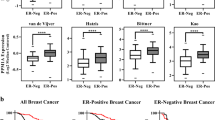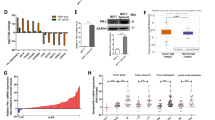Abstract
We previously reported the identification of HRPAP20 (hormone-regulated proliferation-associated protein 20), a novel hormone-regulated, proliferation-associated protein. In tumor cell lines, constitutive HRPAP20 expression enhanced proliferation and suppressed apoptosis, characteristics frequently associated with malignant progression. Here, we report that highly invasive breast cancer cell lines and human breast tumor specimens express elevated HRPAP20, which in transfection experiments in MCF-7 and MDA-MB-231 cells, increased invasion. Results from mechanistic studies revealed that HRPAP20 bound to calmodulin (CaM) via a conserved CaM-binding motif. Transfection of MCF-7 breast cancer cells with HRPAP20 harboring a mutated CaM-binding motif (HRPAP20K73A) inhibited its interaction with CaM and failed to increase invasion. Other experiments revealed that transfection with HRPAP20, but not HRPAP20K73A, increased secretion of matrix metalloproteinase-9 (MMP-9). Moreover, knockdown of HRPAP20 with small interfering RNA in MCF-7/HRPAP20 transfectants and wild-type MDA-MB-231 cells reduced invasion and inhibited secretion of MMP-9. Together these observations suggest that HRPAP20 may be an important regulator of breast tumor cell invasion by a CaM-mediated mechanism that leads to increased MMP-9 secretion. We conclude that dysregulation of HRPAP20 expression in tumor cells may contribute to the observed phenotypic changes associated with breast cancer progression.
This is a preview of subscription content, access via your institution
Access options
Subscribe to this journal
Receive 50 print issues and online access
$259.00 per year
only $5.18 per issue
Buy this article
- Purchase on Springer Link
- Instant access to full article PDF
Prices may be subject to local taxes which are calculated during checkout







Similar content being viewed by others
References
Agell N, Bachs O, Rocamora N, Villalonga P . (2002). Modulation of the Ras/Raf/MEK/ERK pathway by Ca (2+), and calmodulin. Cell Signal 14: 649–654.
Albini A, Iwamoto Y, Kleinman HK, Martin GR, Aaronson SA, Kozlowski JM et al. (1987). A rapid in vitro assay for quantitating the invasive potential of tumor cells. Cancer Res 47: 3239–3245.
Arafah BM, Griffin P, Gordon NH, Pearson OH . (1986). Influence of tamoxifen and estradiol on the growth of human breast cancer cells in vitro. Cancer Res 46: 3268–3272.
Bagchi IC, Huang QH, Means AR . (1992). Identification of amino acids essential for calmodulin binding and activation of smooth muscle myosin light chain kinase. J Biol Chem 267: 3024–3029.
Bartsch JE, Staren ED, Appert HE . (2003). Matrix metalloproteinase expression in breast cancer. J Surg Res 110: 383–392.
Boehning D, Sedaghat L, Sedlak T, Snyder S . (2004). Heme oxygenase-2 is activated by calcium-calmodulin. J Biol Chem 279: 30927–30930.
Crivici A, Ikura M . (1995). Molecular and structural basis of target recognition by calmodulin. Annu Rev Biophys Biomol Struct 24: 85–116.
Di Carlo A, Terracciano D, Mariano A, Macchia V . (2005). Matrix metalloproteinase-2 and matrix metalloproteinase-9 type IV collagenases in serum of patients with pleural effusions. Int J Oncol 26: 1363–1368.
Dumitrescu RG, Cotarla I . (2005). Understanding breast cancer risk – where do we stand in 2005? J Cell Mol Med 9: 208–221.
Ellis MJ . (2003). Breast cancer gene expression analysis – the case for dynamic profiling. Adv Exp Med Biol 532: 223–234.
Enslen H, Tokumitsu H, Stork PJ, Davis RJ, Soderling TR . (1996). Regulation of mitogen-activated protein kinases by a calcium/calmodulin-dependent protein kinase cascade. Proc Natl Acad Sci USA 93: 10803–10808.
Fernandez CA, Yan L, Louis G, Yang J, Kutok JL, Moses MA . (2005). The matrix metalloproteinase-9/neutrophil gelatinase-associated lipocalin complex plays a role in breast tumor growth and is present in the urine of breast cancer patients. Clin Cancer Res 11: 5390–5395.
Fitzsimons DP, Herring BP, Stull JT, Gallagher PJ . (1992). Identification of basic residues involved in activation and calmodulin binding of rabbit smooth muscle myosin light chain kinase. J Biol Chem 267: 23903–23909.
Garbett EA, Reed MWR, Stephenson TJ, Brown NJ . (2000). Proteolysis in human breast cancer. Mol Pathol 53: 99–106.
Glinsky GV, Glinsky VV, Ivanova AB, Hueser CN . (1997). Apoptosis and metastasis: increased apoptosis resistance of metastatic cancer cells is associated with the profound deficiency of apoptosis execution mechanisms. Cancer Lett 115: 185–193.
Haupt LM, Thompson EW, Trezise AE, Irving RE, Irving MG, Griffiths LR . (2006). In vitro and in vivo MMP gene expression localisation by in situ-RT–PCR in cell culture and paraffin embedded human breast cancer cell line xenografts. BMC Cancer 6: 18.
Hoeflich KP, Ikura M . (2002). Calmodulin in action: diversity in target recognition and acivation mechanisms. Cell 108: 739–742.
James P, Vorherr T, Carafoli E . (1995). Calmodulin-binding domains: just two faced or multi-faceted? Trends Biochem Sci 20: 38–42.
Karp CM, Pan H, Zhang M, Buckley DJ, Schuler LA, Buckley AR . (2004). Identification of HRPAP20: a novel phosphoprotein that enhances growth and survival in hormone-responsive tumor cells. Cancer Res 64: 1016–1025.
La Rocca G, Pucci-Minafra I, Marrazzo A, Taormina P, Minafra S . (2004). Zymographic detection and clinical correlations of MMP-2 and MMP-9 in breast cancer sera. Br J Cancer 90: 1414–1421.
Leonessa F, Boulay V, Wright A, Thompson EW, Brunner N, Clarke R . (1992). The biology of breast tumor progression. Acquisition of hormone independence and resistance to cytotoxic drugs. Acta Oncol 31: 115–123.
Li HC, Cao DC, Liu Y, Hou YF, Wu J, Lu JS et al. (2004). Prognostic value of matrix metalloproteinases (MMP-2 and MMP-9) in patients with lymph node-negative breast carcinoma. Breast Cancer Res Treat 88: 75–85.
Mariani G . (2005). Molecular staging of the sentinel lymph node in melanoma patients: correlation with clinical outcome. Ann Oncol 16: 191–194.
Mendes O, Kim HT, Stoica G . (2005). Expression of MMP2, MMP9 and MMP3 in breast cancer brain metastasis in a rat model. Clin Exp Metastasis 22: 237–246.
Miyazaki K, Funahashi K, Umeda M, Nakano A . (1994). Gelatinase A and APP. Nature 368: 695–696.
Murphy G, Reynolds JJ, Hembry RM . (1989). Metalloproteinases and cancer invasion and metastasis. Int J Cancer 44: 757–760.
Nakajima M, Welch DR, Belloni PN, Nicolson GL . (1987). Serum and plasma M(r) 92,000 progelatinase levels correlate with spontaneous metastasis of rat 13762NF mammary adenocarcinoma. Cancer Res 47: 4869–4876.
Paquette B, Bisson M, Baptiste C, Therriault H, Lemay R . (2005). Invasiveness of breast cancer cells MDA-MB-231 through extracellular matrix is increased by the estradiol metabolite 4-hydroxyestradiol. Int J Cancer 113: 706–711.
Pellikainen JM, Ropponen KM, Kataja VV, Kellokoski JK, Eskelinen MJ, Kosma VM . (2004). Expression of matrix metalloproteinase (MMP)-2 and MMP-9 in breast cancer with a special reference to activator protein-2, HER2, and prognosis. Clin Cancer Res 10: 7621–7628.
Przybylowska K, Kluczna A, Zadrozny M, Krawczyk T, Kulig A, Rykala J et al. (2005). Polymorphisms of the promoter regions of matrix metalloproteinases genes MMP-1 and MMP-9 in breast cancer. Breast Cancer Res Treat 95: 65–72.
Rahko E, Jukkola A, Melkko J, Paavo P, Bloigu R, Talvensaari-Mattila A et al. (2004). Matrix metalloproteinase-9 (MMP-9) immunoreactive protein has modest prognostic value in locally advanced breast carcinoma patients treated with an adjuvant antiestrogen therapy. Anticancer Res 24: 4247–4253.
Ranuncolo SM, Armanasco E, Cresta C, Bal De Kier Joffe E, Puricelli L . (2003). Plasma MMP-9 (92 kDa-MMP) activity is useful in the follow-up and in the assessment of prognosis in breast cancer patients. Int J Cancer 106: 745–751.
Reich R, Thompson EW, Iwamoto Y, Martin GR, Deason JR, Fuller GC et al. (1988). Effects of inhibitors of plasminogen activator, serine proteinases, and collagenase IV on the invasion of basement membranes by metastatic cells. Cancer Res 48: 3307–3312.
Repesh LA . (1989). A new in vitro assay for quantitating tumor cell invasion. Invas Metast 9: 192–208.
Rhoads AR, Friedberg F . (1997). Sequence motifs for calmodulin recognition. FASEB J 11: 331–340.
San Jose E, Benguria A, Geller P, Villalobo A . (1992). Calmodulin inhibits the epidermal growth factor receptor tyrosine kinase. J Biol Chem 267: 15237–15245.
Schmitt M, Janicke F, Grae VH . (1990). Tumour-associated fibrinolysis: the prognostic relevance of plasminogen activators uPA and tPA in human breast cancer. Blood Coagul Fibrinolysis 1: 695–702.
Sliva D . (2004). Signaling pathways responsible for cancer cell invasion as targets for cancer therapy. Curr Cancer Drug Targets 4: 327–336.
Strobl JS, Wonderlin WF, Flynn DC . (1995). Mitogenic signal transduction in human breast cancer cells. Gen Pharmacol 26: 1643–1649.
Stuelten CH, DaCosta BS, Arany PR, Karpova TS, Stetler-Stevenson WG, Roberts AB . (2005). Breast cancer cells induce stromal fibroblasts to express MMP-9 via secretion of TNF-alpha and TGF-beta. J Cell Sci 118 (Part 10): 2143–2153.
Subramaniam DS, Isaacs C . (2005). Utilizing prognostic and predictive factors in breast cancer. Curr Treat Options Oncol 6: 147–159.
Suzuki M, Raab G, Moses MA, Fernandez CA, Klagsbrun M . (1997). Matrix metalloproteinase-3 releases active heparin-binding EGF-like growth factor by cleavage at a specific juxtamembrane site. J Biol Chem 272: 31730–31737.
Talvensaari-Mattila A, Turpeenniemi-Hujanen T . (2005). Preoperative serum MMP-9 immunoreactive protein is a prognostic indicator for relapse-free survival in breast carcinoma. Cancer Lett 217: 237–242.
Weigelt B, Peterse JL, Van’t Veer LJ . (2004). Detection of metastases in sentinel lymph nodes of breast cancer patients by multiple mRNA markers. Br J Cancer 90: 1531–1537.
Williams GT, Smith CA . (1993). Molecular regulation of apoptosis: genetic controls on cell death. Cell 74: 777–779.
Acknowledgements
This work was supported in part by grants from the Susan G Komen Breast Cancer Foundation (CMK, Dissertation Research Award) and the University of Cincinnati Cancer Center.
Author information
Authors and Affiliations
Corresponding author
Rights and permissions
About this article
Cite this article
Karp, C., Shukla, M., Buckley, D. et al. HRPAP20: a novel calmodulin-binding protein that increases breast cancer cell invasion. Oncogene 26, 1780–1788 (2007). https://doi.org/10.1038/sj.onc.1209980
Received:
Revised:
Accepted:
Published:
Issue Date:
DOI: https://doi.org/10.1038/sj.onc.1209980
Keywords
This article is cited by
-
Screening and identification of potential biomarkers and therapeutic drugs in melanoma via integrated bioinformatics analysis
Investigational New Drugs (2021)
-
Eukaryotic complex I: functional diversity and experimental systems to unravel the assembly process
Molecular Genetics and Genomics (2008)



